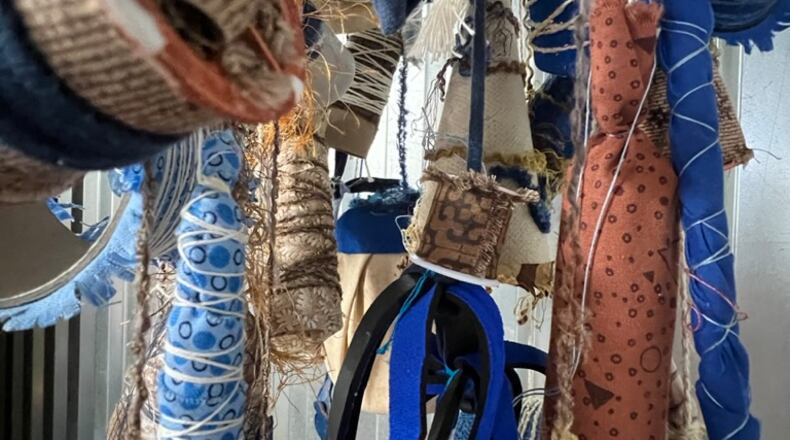Aimee Wissman and Kamisha Thomas, co-founders of The Returning Artists Guild (RAG) and organizers of the exhibit, are self-taught artists who met while incarcerated at Dayton Correctional Institution, a state prison for women. The art collective began to coalesce in 2015 when Wissman, Thomas, and a group of other artists, including Hoop, formed an art therapy program while in prison.
After being released, Wissman and Thomas kept in touch, holding pop-up art exhibitions showing the work of currently and formerly incarcerated artists, and formally launching RAG in 2018.
Credit: Contributed
Credit: Contributed
Growing research points toward the positive effects that creative expression has on the mental health of inmates, including their rehabilitation towards re-entering life outside prison. However, access to art materials and opportunities to use them vary greatly from prison to prison.
Dayton Correctional offers an art class taught by Wilmington College, though enrollment is limited to those who have the knowledge base to apply. In other words, it is not easily accessible.
“In prison, you are not allowed to have much of anything,” said Wissman.
“Most of our artists take it upon themselves to create — to find materials, conceive the idea and put together those materials. Regardless of where the making happens, it’s still under the conditions of confinement.”
The artmaking takes place in cells or recreation rooms.
“Art making is the healthiest way we have to express our emotions. The prison doesn’t respect creative practices — people that are inside have no access to it. We long to be individuals in this place where you are stripped of your individuality.”
RAG helps incarcerated artists by providing art supplies, shipping and transporting artwork, and by developing professional practices such as documenting artwork and securing exhibitions.
They also support the creative practices and professional development of artists who have re-entered life outside of prison.
FINDING JOY
A painter and filmmaker whose work is in the permanent collection of the U.S. Department of Justice, Wissman struggled with addiction for a decade before entering Dayton Correctional.
She remembers being excited to move into the same housing unit as Hoop.
“I jokingly called her and her posse of girls ‘my grandmas’. They all knew how to use fiber and make things that could keep you warm or let you hold onto something.
“Joy had a kind of passion and restlessness about her that was different, something I wanted to be around. It seemed like Joy had a love of learning something new and a willingness to fail in pursuit of creative action — to make something, anything outside the reality of being inside.”
THE BLUE HOUSE CONNECTION
Wissman and Jonas met while the latter was installing a show of her own work at the Riffe Gallery in Columbus. The two re-connected when Blue House helped organize a symposium for artist-run spaces. They invited RAG to participate in a panel titled Artist-Run as Community Engine.
“I had been hoping to figure out an exhibition with Aimee and Kamisha for about a year, and when it came to us having a budget to bring them in, they gave space to a fellow artist. I really appreciate the navigation they had to do to make this a reality,” said Nicholaus Arnold.
Wissman and Thomas collected artwork from Hoop during visitations, amassing an impressive collection for the exhibit. The work is for sale with all proceeds going directly to the artist, who can spend it on the prison commissary or internet access.
All artists who participate in exhibitions at Blue House receive compensation for their time and work through funding from the Montgomery County Grant Program. Blue House has been awarded with the grant over the past four consecutive years and it is part of their ethos to compensate artists with a fair wage.
Credit: Hannah Kasper
Credit: Hannah Kasper
“This year we had the opportunity to offer (RAG) the space to create a show that’s both real, local, and important. They brought us Joy, both literally and figuratively,” said Arnold.
The opening night packed the in-house gallery with both old friends and new visitors. Arnold and Jonas sent Hoop video from the event, though the three have never directly communicated.
THE ART OF JOY HOOP
To create her art, Hoop utilizes found material and repurposed objects, including trash, sourced in her environment at the Dayton Correctional Institution, where she has been incarcerated for 28 years. She uses material that is within her reach — discarded clothing, recycled cardboard, leftover paint — to create tactile sculptures and collages.
The exhibit at Blue House can be characterized as mixed media due to the nature of the materials. There is a variety of fiber-based sculptural work on view. Works on canvas lean towards the textural and three dimensional with collaged canvas pieces and materials extruding from the surface.
One is impressed by the sophistication of the color and ingenuity of materials achieved with so little.
“You can’t help but become an expert in the thing, because you’re so invested in the process. Something inevitably beautiful will come of it. That’s how it’s authentic,” said Jonas.
“The Situation” features hundreds, if not thousands, of hand-applied staples pressed into canvas, since Hoop was not allowed a stapler.
“Each piece of work is intentional. How am I feeling? Is there a message? Then I begin a meticulous process of collecting and assemblage,” said Hoop of her work.
Wissman reflects on the curatorial side of the show.
“As you consider her work you may be able to identify a symbolic and carceral language she’s using through her use of material, technique, repetition, and structure.”
Credit: Contributed
Credit: Contributed
There is a mosaic-like collage, “Wrong Side of Town”, that points to this language. Like a Piet Mondrian painting, the composition is made up of colorful squares in a tidy composition, but instead of joyful movement, there is constriction — lots of little canvas squares squeezed together in a maze of columns and rows, dizzying in their density. They may represent a fence that contains. Patterning and repetition here refer to the counting of time.
Wissman elaborates.
“A lot of things are laid out in grids, in rows, organized in a way that you could understand as brinks locks, thinking about a cell.”
Brink is a manufacturer of high security mechanical locks for prisons.
“You could think about the grid like a fence. A lot of materials are bound, constrained. These methods and materials can all be likened to what Joy experiences inside. Her process reflects her environment,” said Wissman.
Credit: Contributed
Credit: Contributed
“Proceed with Caution” is a hanging mobile composed of a broken fan and other materials — fabric, cardboard rolls, plastic sewing spools — which are wrapped in tones of blue fabric and bound tightly in lengths of twine and string. Her inmate identification number hangs from a card amidst the textiles.
This number is used for tracking and managing various aspects of an inmate’s life within the system. It is used for things like commissary accounts, sending mail, and visitation.
“The non-objective repetition is so meditative. If you think about some religious practices, it’s the consistency of doing an action over and over again,” said Jonas.
“Her skill in using the waste of carceral space to communicate the limitations of confinement through the arrangement of grids, units, and barriers, speaks to a deeper understanding of the nature of masking in plain sight what is essentially a deep critique of and rage toward the true psychological harm of incarceration,” said Wissman.
The work is also playful.
In “Paint Brush Pal”, Hoop saved leftover bread and microwaved it until the moisture was removed. She then used her hands to manipulate and sculpt the bread like clay, pressing it to cover the handle of a large paintbrush before adding bits of hair-like string.
The result is an abstracted face, and a utilitarian object given the warmth of life. Part Jasper Johns, part Wilson the Volleyball, but authentically full of humanity.
Credit: Hannah Kasper
Credit: Hannah Kasper
The extensive collection on view at Blue House, produced between 2020 and 2025, provides a glimpse into the life of a woman who has been incarcerated for half her life. In Hoop’s words, in her twenty-eight years behind bars she has experienced “the devastating low of guilt and shame, the excruciating pain of grief and loss, and finally, through hope, the profound beauty of being herself”.
She asks the viewer to search beyond the canvas when viewing the work.
“You will discover the mundane, the marginalized, the isolated, the hope, the triumph, and the overwhelming resilience of human spirit,” said Hoop.
MARKING TIME, MAKING ART
Wissman reflects on her experience making art while incarcerated, and on her admiration of Hoop.
“When they have taken everything from you, there’s nothing left to lose. I wish more than anything she was here in the studio with me. In using her artist voice, Joy has autonomy and freedom right now.”
There is an application on The Returning Artists Guild website for those interested in becoming a member. As far as artists who are still inside, they are referred by other members of the RAG.
Blue House Arts puts on four exhibitions a year, two in the fall and two in the spring. They hope to mount ongoing annual shows that feature RAG artists.
HOW TO GO
What: The Returning Artists Guild presents “Enough is Enough: Who You Are, Where You Are”, works by Joy Hoop
When: Through May 31, Open gallery hours Fridays 4-6 P.M.
Where: The Blue House Arts, 3325 Catalpa Drive, Dayton
Contact: 937-829-8016 and thebluehousearts.org
More details: Free and open to the public
For more backstory on The Returning Artists Guild, check out the WYSO-produced segment, Re-Entry Stories, and the podcast “Call Declined”, produced by the Sozosei Foundation, whose mission is to decriminalize mental illness.
About the Author





